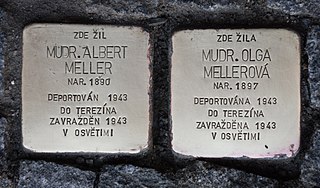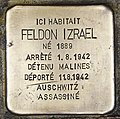
Drancy internment camp was an assembly and detention camp for confining Jews who were later deported to the extermination camps during the German occupation of France during World War II. Originally conceived and built as a modernist urban community under the name La Cité de la Muette, it was located in Drancy, a northeastern suburb of Paris, France.

On 19 April 1943, members of the Belgian Resistance stopped a Holocaust train and freed a number of Jews who were being transported to Auschwitz concentration camp from Mechelen transit camp in Belgium, on the twentieth convoy from the camp. In the aftermath of the attack, a number of others were able to jump from the train too. In all, 233 people managed to escape, of whom 118 ultimately survived. The remainder were either killed during the escape or were recaptured soon afterwards. The attack was unusual as an attempt by the resistance to free Jewish deportees and marks the only mass breakout by deportees on a Holocaust train.

A Stolperstein is a ten-centimetre (3.9 in) concrete cube bearing a brass plate inscribed with the name and life dates of victims of Nazi extermination or persecution. Literally, it means 'stumbling stone' and metaphorically 'stumbling block'.

Jozef-Ernest van Roey was a Belgian Cardinal of the Roman Catholic Church. He served as Archbishop of Mechelen from 1926 until his death, and was elevated to the cardinalate in 1927. He was significant figure in Catholic resistance to Nazism in Belgium.

Holocaust trains were railway transports run by the Deutsche Reichsbahn and other European railways under the control of Nazi Germany and its allies, for the purpose of forcible deportation of the Jews, as well as other victims of the Holocaust, to the Nazi concentration, forced labour, and extermination camps.

The Mechelen transit camp, officially SS-Sammellager Mecheln in German, also known as the Dossin barracks, was a detention and deportation camp established in a former army barracks at Mechelen in German-occupied Belgium. It served as a point to gather Belgian Jews and Romani ahead of their deportation to concentration and extermination camps in Eastern Europe during the Holocaust.

Gisi Fleischmann was a Zionist activist and the leader of the Bratislava Working Group, one of the best known Jewish rescue groups during the Holocaust. Fleischmann was arrested on 15 October 1944 and was murdered in the Auschwitz concentration camp three days later.

Victor Martin was a Belgian academic sociologist. He was known for his involvement with the Belgian Resistance during World War II.

The Holocaust in France was the persecution, deportation, and annihilation of Jews between 1940 and 1944 in occupied France, metropolitan Vichy France, and in Vichy-controlled French North Africa, during World War II. The persecution began in 1940, and culminated in deportations of Jews from France to Nazi concentration camps in Nazi Germany and Nazi-occupied Poland. The deportation started in 1942 and lasted until July 1944. Of the 340,000 Jews living in metropolitan/continental France in 1940, more than 75,000 were deported to death camps, where about 72,500 were murdered.

The Holocaust in Belgium was the systematic dispossession, deportation, and murder of Jews and Roma in German-occupied Belgium during World War II. Out of about 66,000 Jews in the country in May 1940, around 28,000 were murdered during the Holocaust.

The Stolpersteine in Prague-Josefov lists the Stolpersteine in the town quarter Josefov of Prague, the former Jewish quarter of the city. Stolpersteine is the German name for stumbling blocks collocated all over Europe by German artist Gunter Demnig. They remember the fate of the Nazi victims being murdered, deported, exiled or driven to suicide.

The Stolpersteine in the Ústí nad Labem Region lists the Stolpersteine in the Ústí nad Labem Region in the north-west of the Czech Republic. Stolpersteine is the German name for stumbling blocks collocated all over Europe by German artist Gunter Demnig. They remember the fate of the Nazi victims being murdered, deported, exiled or driven to suicide.

The Stolpersteine in the Jihočeský kraj lists the Stolpersteine in the Czech region Jihočeský kraj. Stolpersteine is the German name for stumbling blocks collocated all over Europe by German artist Gunter Demnig. They help us remember the fate of the Nazi victims being murdered, deported, exiled or driven to suicide.

The Stolpersteine in Ratenice lists the Stolpersteine in Ratenice in the Central Bohemian Region, the central part of Bohemia. Stolpersteine is the German name for stumbling blocks collocated all over Europe by German artist Gunter Demnig. They remember the fate of the Nazi victims being murdered, deported, exiled or driven to suicide.

The Stolpersteine in the Pardubický lists the Stolpersteine in the Pardubice Region in the east of Bohemia. Stolpersteine is the German name for stumbling blocks collocated all over Europe by German artist Gunter Demnig. They remember the fate of the Nazi victims being murdered, deported, exiled or driven to suicide.

The Stolpersteine in Lomnice u Tišnova lists the Stolpersteine in the town Lomnice in the South Moravian Region. Stolpersteine is the German name for stumbling blocks collocated all over Europe by German artist Gunter Demnig. They remember the fate of the Nazi victims being murdered, deported, exiled or driven to suicide.

The Stolpersteine in Mikulov, Slavkov u Brna and Znojmo lists the Stolpersteine in three towns of the South Moravian Region. Stolpersteine is the German name for stumbling blocks collocated all over Europe by German artist Gunter Demnig. They remember the fate of the Nazi victims being murdered, deported, exiled or driven to suicide.

Stolpersteine is the German name for small, cobble stone-sized memorials installed all over Europe by German artist Gunter Demnig. They remember the fate of the victims of Nazi Germany being murdered, deported, exiled or driven to suicide. The first Stolperstein in Genoa, the capital of the Italian region of Liguria, was installed in January 2012.

Stolpersteine is the German name for stumbling blocks collocated all over Europe by German artist Gunter Demnig. They remember the fate of the victims of Nazi Germany being murdered, deported, exiled or driven to suicide. The first Stolpersteine of the Trnavský kraj, the Trnava Region of present-day Slovakia, were collocated in August 2016.

Maxime Steinberg (1936–2010) was a Belgian historian and teacher who wrote extensively on the Holocaust in Belgium. He has been described as "Belgium's principal Holocaust historian" and was best known for his three-part history of the subject entitled L'Étoile et le Fusil, published in 1983–87.
































